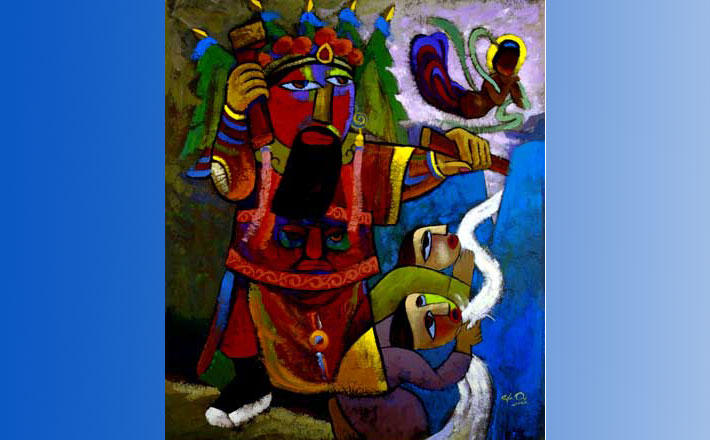Commentary on Psalm 25:1-9
It never ceases to amaze me how a person’s capacity to review the contours of their life decisions can adjust how they perceive the past, understand the present, or discern how to make good decisions in the future.
In this Psalm, the writer engages in a poetic reverie punctuated by reflections on the nature of God and recognition of human nature. It is a prayer that starts with trust in God and an abiding hope in the capacity of God to impact one’s life for the better. It ends with an affirmation of God’s essence as being good and upright.
Threaded between the beginning and end is a dance of human living in the presence of God. Good decisions are mixed with bad. Trust lines and marks from a lack of trust flow back and forth across the text like a Giacometti drawing. It is sometimes difficult to see which line leads to which conclusion. How does a decision shape a future line that could either be in accordance with the will of God or counter to it? Yet, collectively they form the image of what has been or what is present.
The Psalmist’s prayer entreats God to be a teacher, guide, and instructor who can provide insight about what makes a life worth living. The prayer massages an enduring emotional legacy of guilt and shame for past misdeeds with words of comfort and hope. What the exact nature of the guilt or shame is left undefined and perhaps that aids the hearer or reader in empathizing with the writer. They fill in the story with their own story so that the Psalmist’s prayer can become their own.
The Psalmist’s poem also sounds like that of one pleading to find a way out of their dire predicament or from what may be occluding their vision of what makes for a good life. What the Psalmist was facing isn’t clear, but the emotional experience seems familiar. Those who have experience with the consequences of bad decisions know how they can impact the mind and emotional outlook on everything around them. Those who have looked at the possibilities and implications of difficult situations and decisions know from life experience that bad things can happen if a decision is made incorrectly, and bad things can just happen.
Those who have experience with driving a car know that car accidents happen. In my experience, they happen when you least expect them. For example, while driving our car on a tree-lined country road a deer sprinted directly across our path. My wife and I discovered quickly that our gentle Mother’s Day ride had developed into something quite different than we had expected. The same could be said for the deer. Sometimes layers of instruction and miles of experience cannot avoid a collision. Bad things can happen.
The writer’s poetry swirls through words like a dust devil picking up themes and ideas from one place to have them land in another. The desires of a student to learn are commingled with God as teacher who can provide that which is desired and will bring about a fullness of life. The impact of a teacher on one’s life cannot be overstated. People often state that the most influential persons in their life stories are a parent, sibling, or teacher. The writing suggests an awareness of the impact that good teaching can have on one’s life. The Psalmist is entreating God to be their teacher so that their life journey might be worth living.
Show me, teach me, and guide me are English translations of the Hebrew text. Great teaching has a capacity to do all three. In order to graphically show what it is that teachers want students to learn, contemporary classroom teachers frequently use concept maps in their lesson planning and in their teaching practice. They are visually graphic ways to illustrate what it is that they are trying to teach students to learn. They use them in classrooms to help students see the correlation of ideas better. They break down ideas and show students the various pieces of an overall argument so that they can better connect them to key concepts and ideas. They visually depict correlations between ideas so that the ideas themselves can be grasped better and linked to other ideas so as to create stickiness in the student’s learning process.
The teaching process then ties what is shown to the student so as to arrive at the desired goals of learning. This learning then can provide the foundation for subsequent learning of increasing complexity of concepts and ideas. In addition to the illustration of ideas and the process of instruction, teachers routinely engage in mentoring students toward greater depths of understanding. There is a guiding process that occurs along the way in concert with one’s education that helps cement the pieces of learning together so that they become part of the structure of one’s life and life decision-making.
The Psalmist regards God as teacher to be the only teacher who can guide him toward that which will bring about a good life. There are theological affirmations threaded throughout the Psalm that describe God as teacher who can be trusted, who has a capacity to stop powers that would undermine one’s life, who can illustrate the ways and paths that lead to a life worth living, and who is good and upright.
Perhaps at its foundation the Psalm writer is wrestling with a question of formation. What is it that leads to a life worth living? What are the things that would impede a life worth living? How can one be guided toward that which is worthy and away from that which would be less than helpful for living?
Here the writer’s answer seems to be one that sloshes back and forth between what denudes life and what helps a life to flourish. On one side there is treachery without cause, sin, and rebelliousness toward the ways and on the other side there is a cognizance of what God has already provided to the people of God. The Pentateuch has shown what God would regard as good and right for living and they are rooted in the law of God and the creator’s designs for the flourishing of life.


October 1, 2017